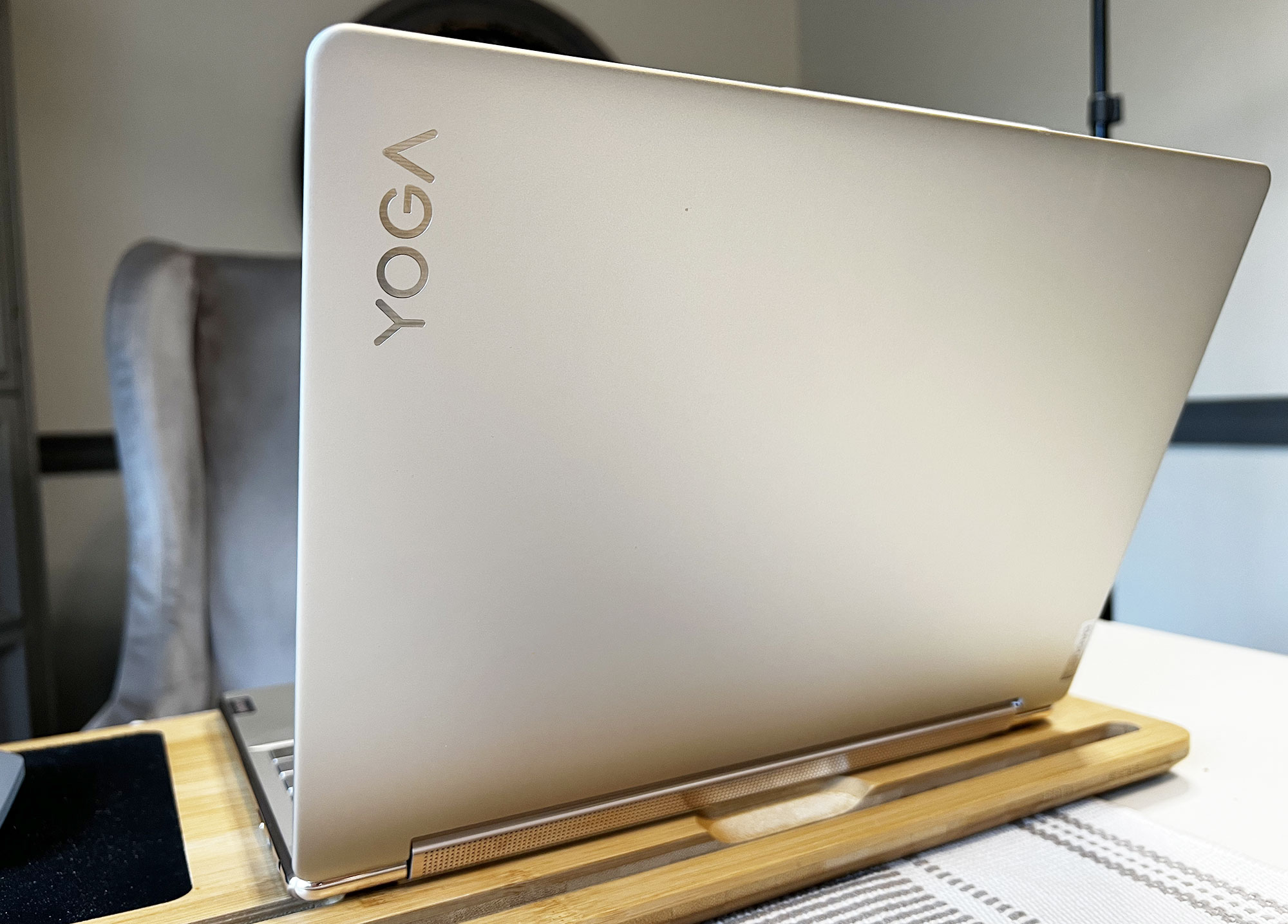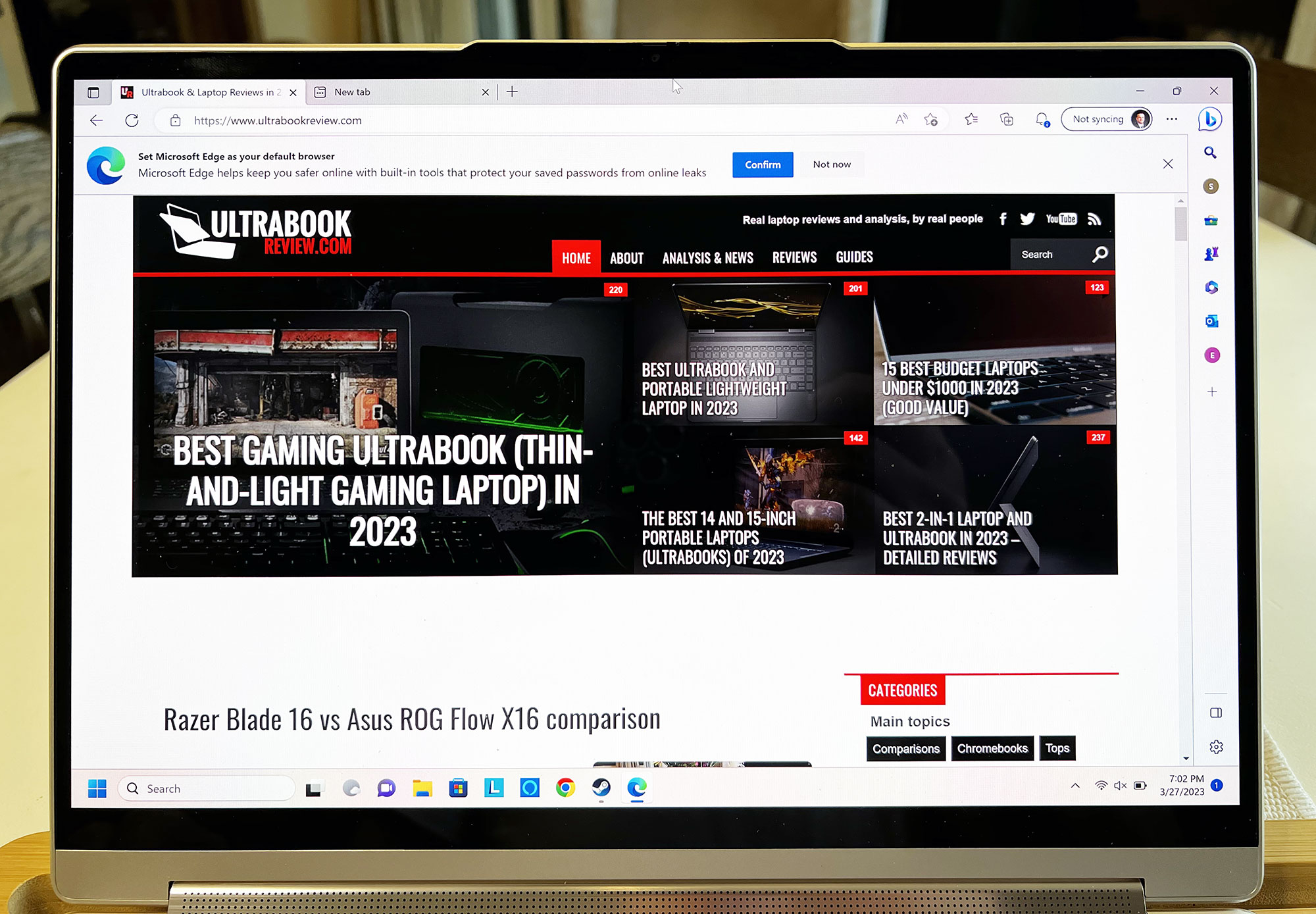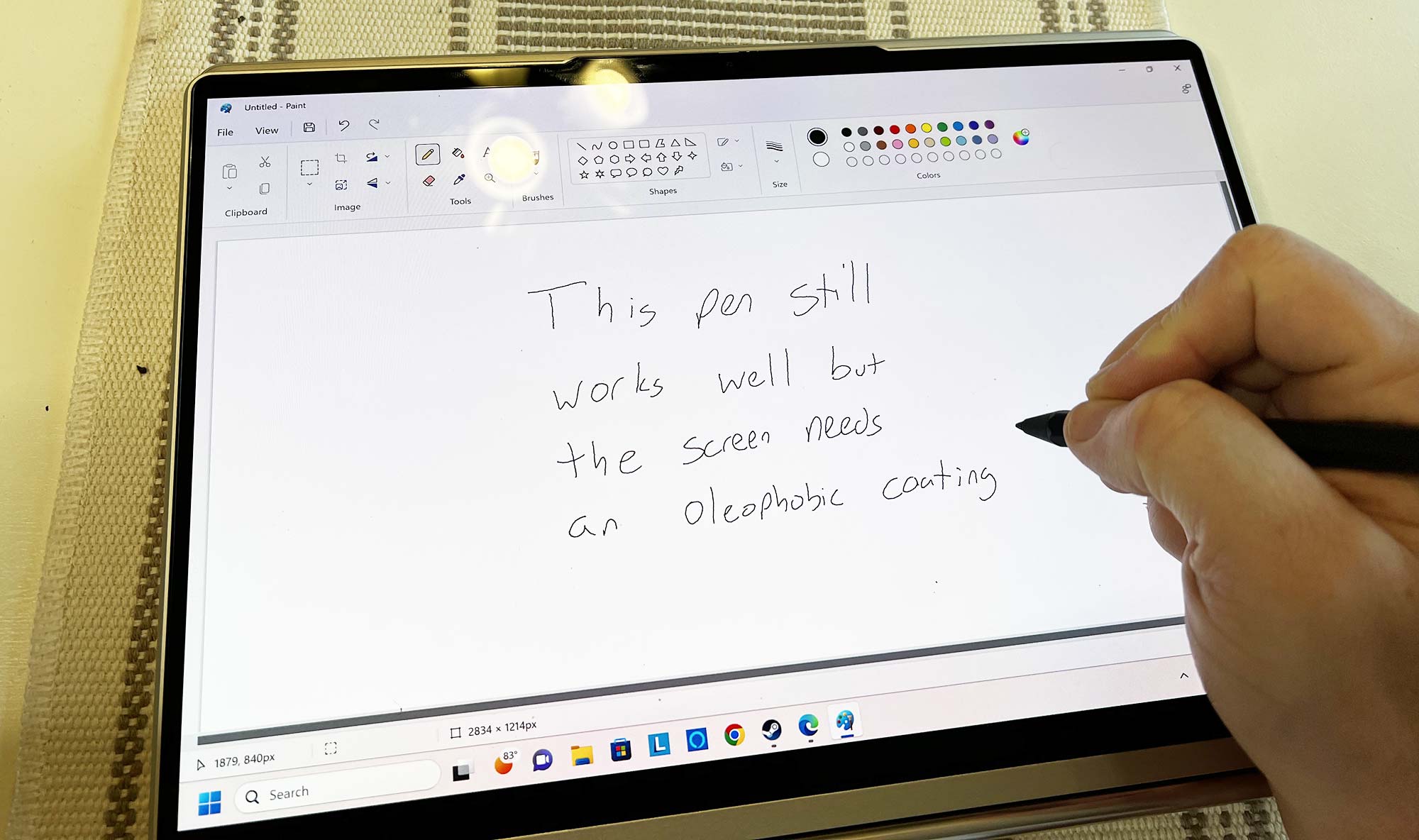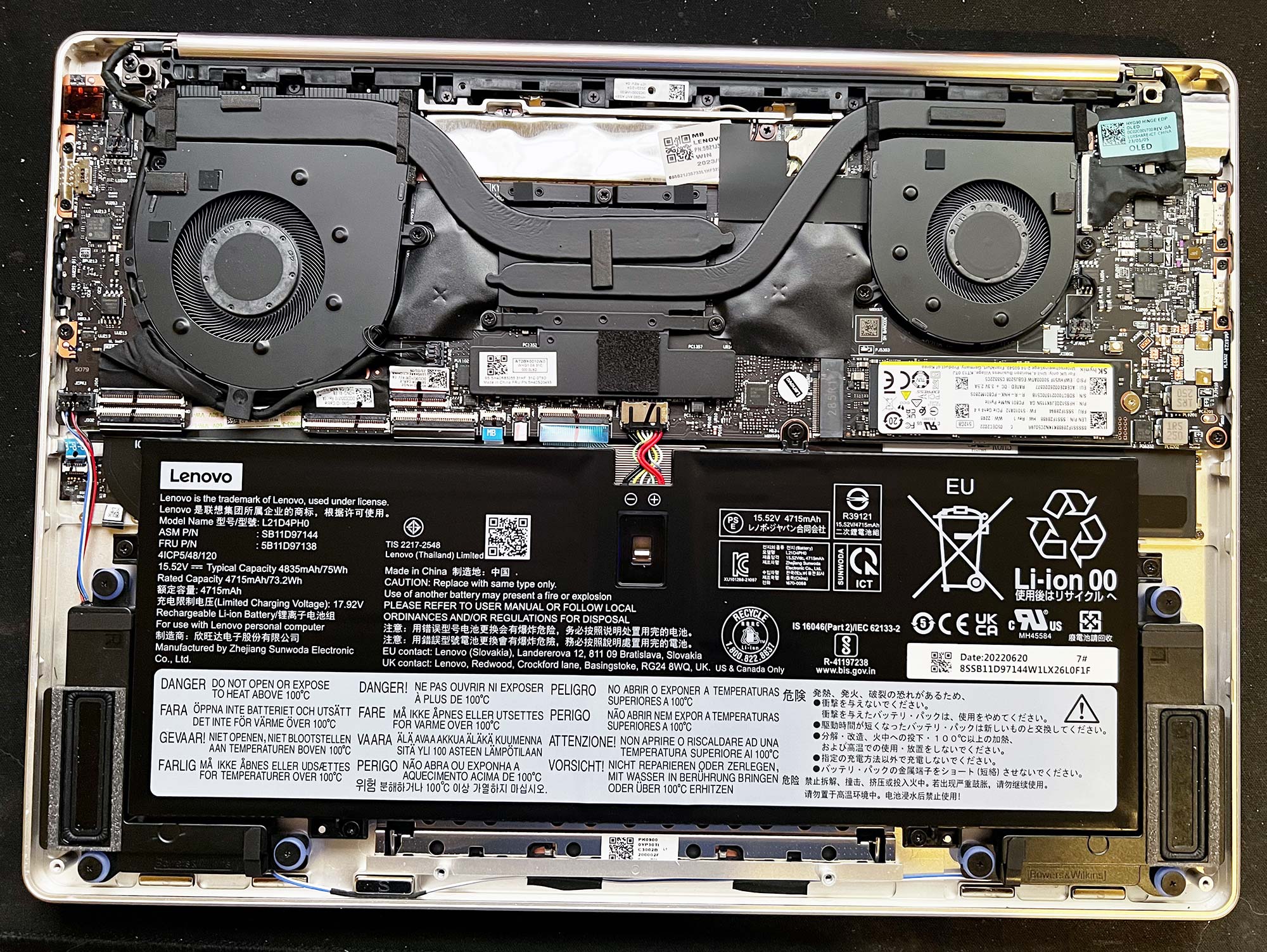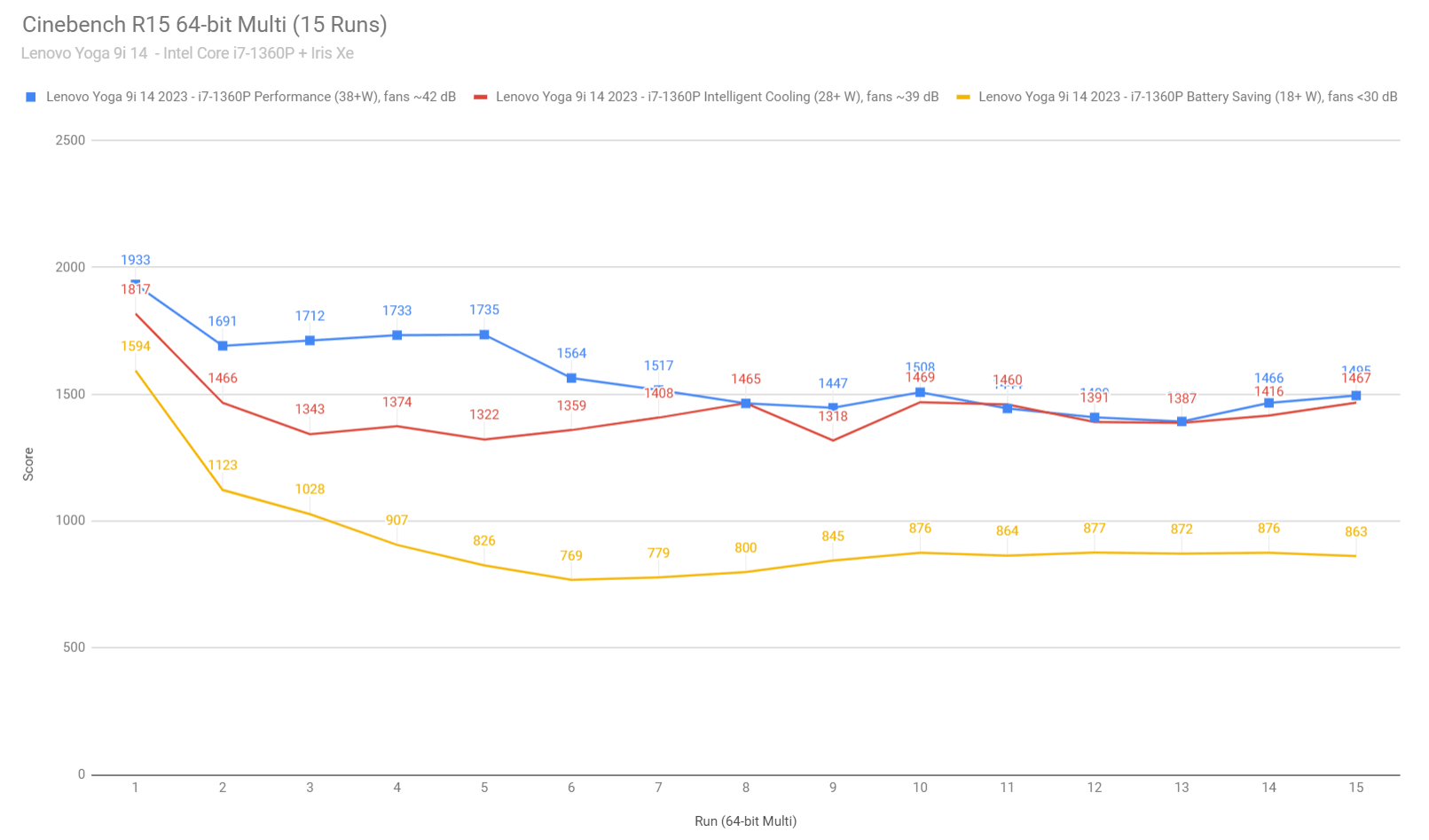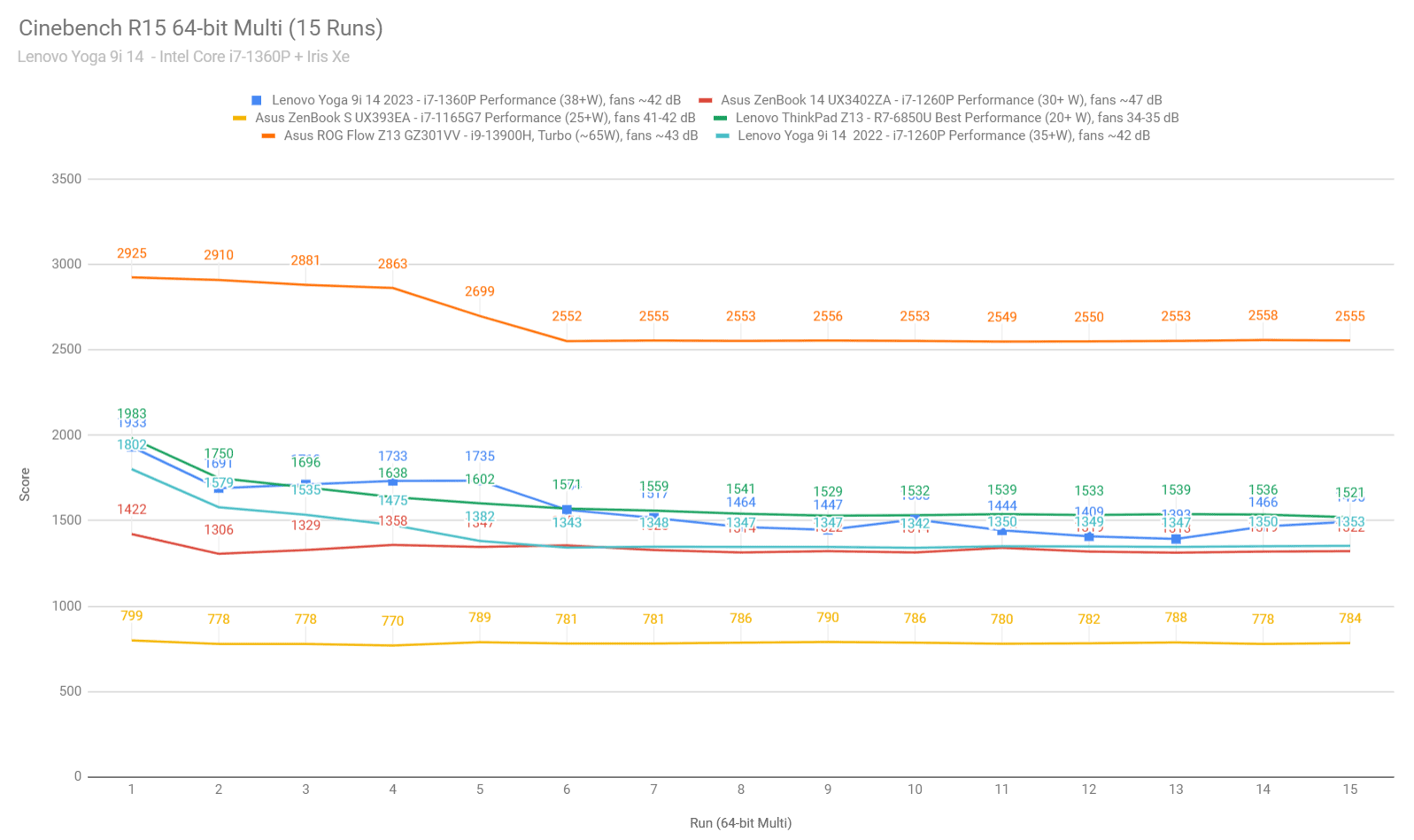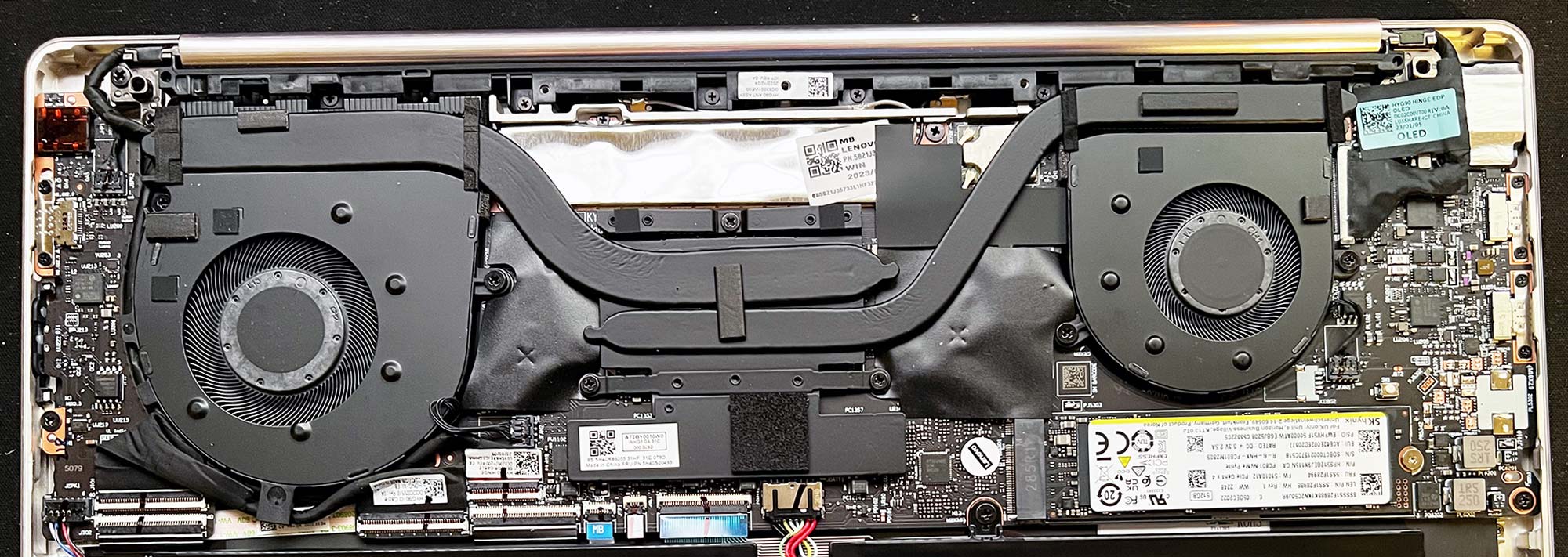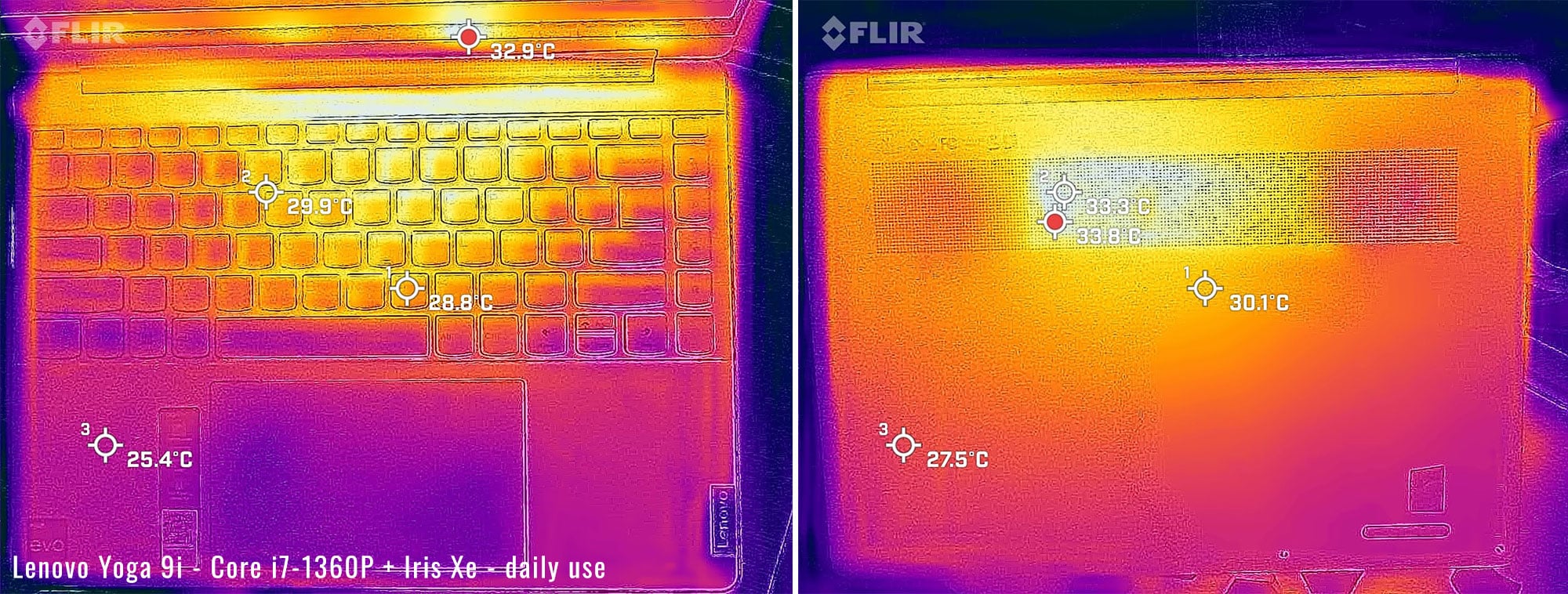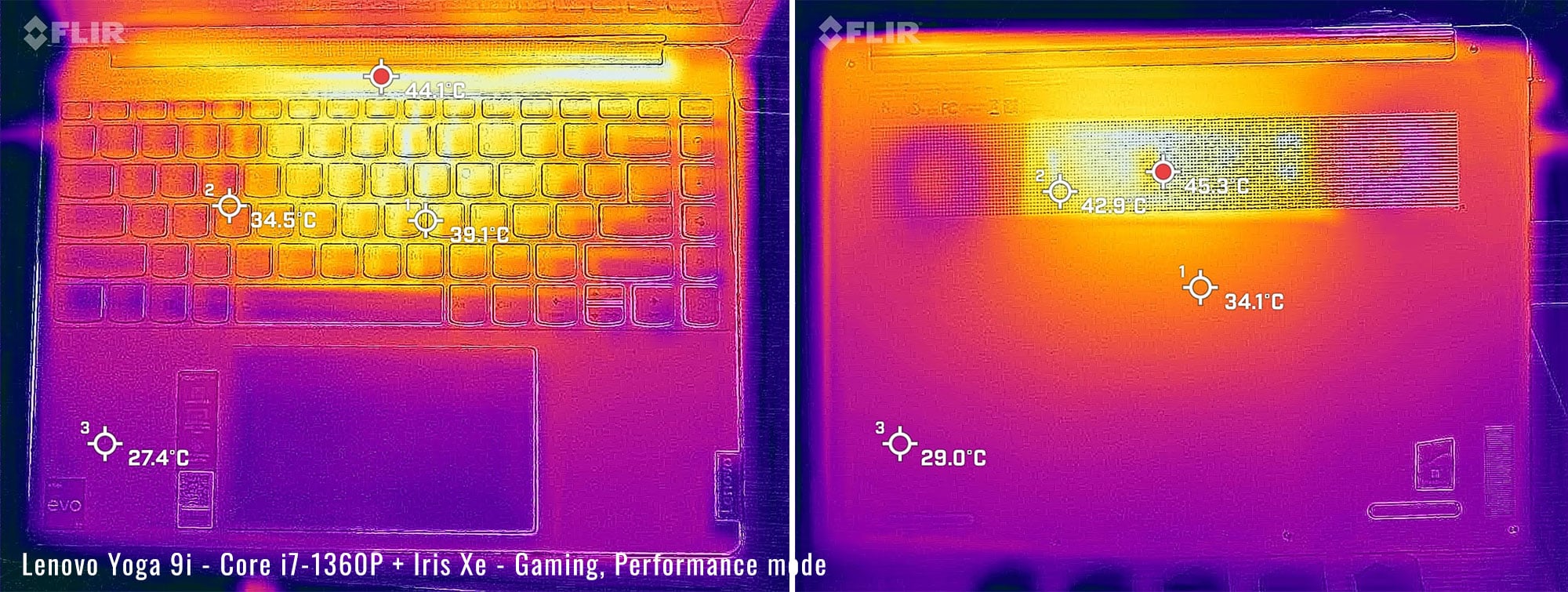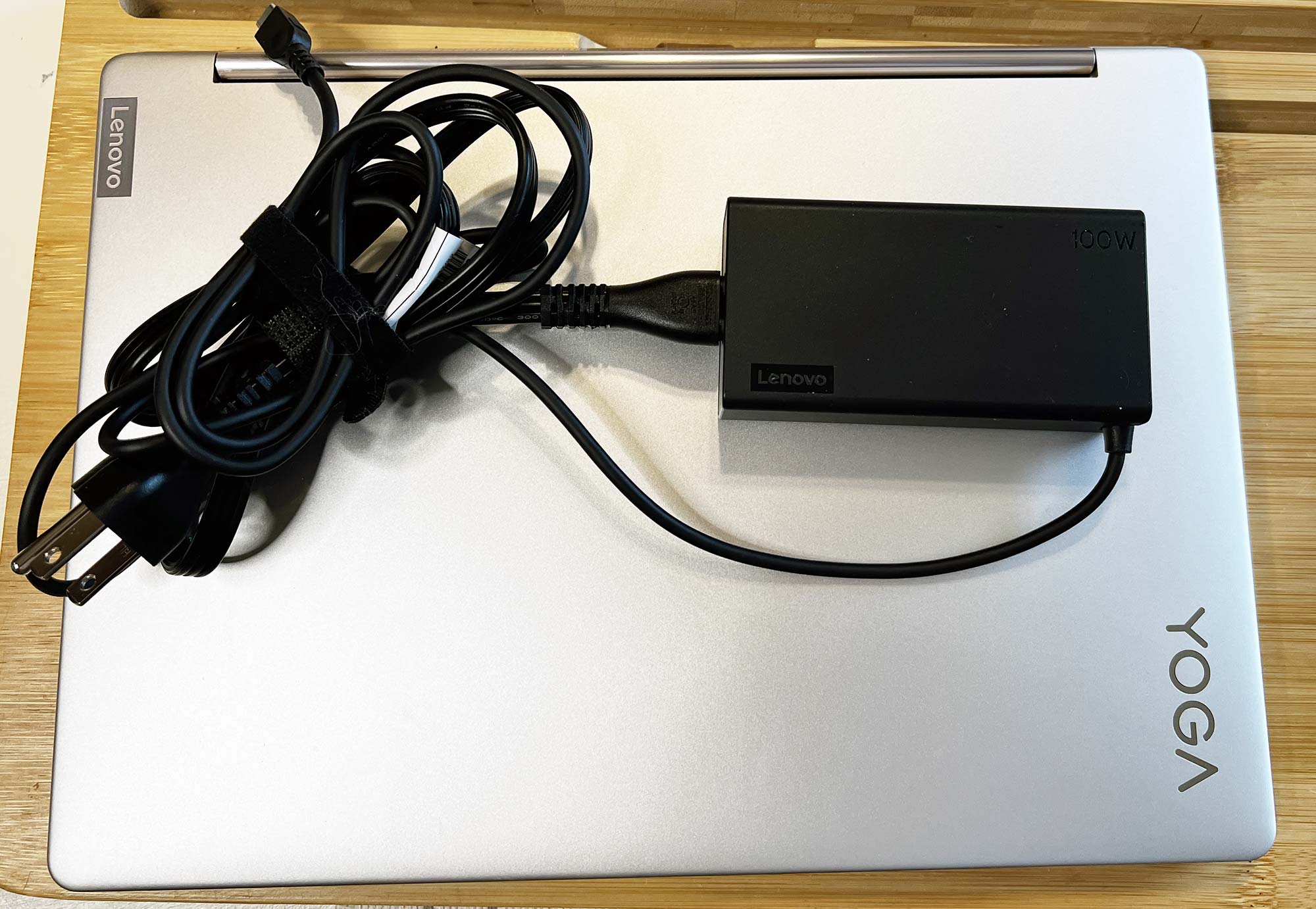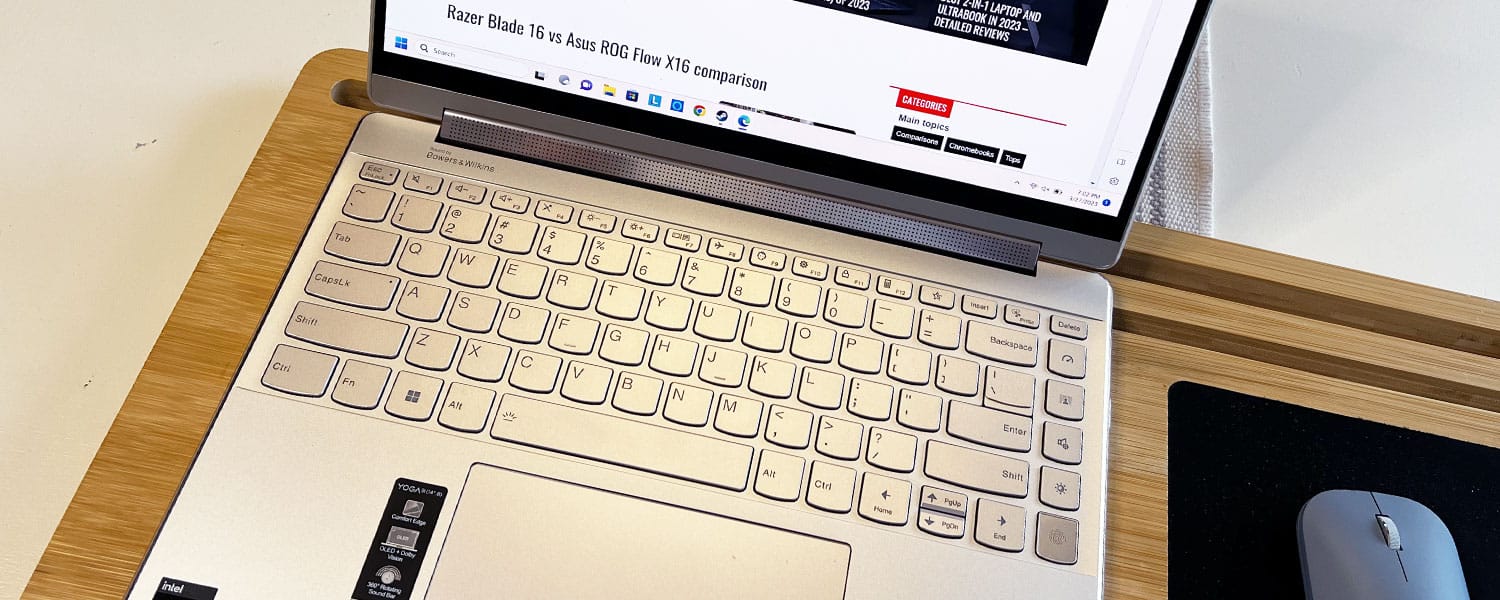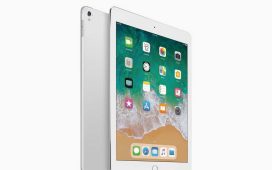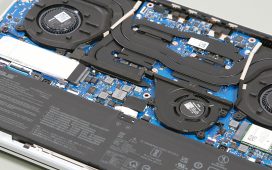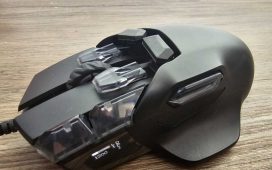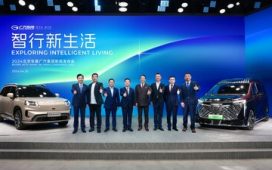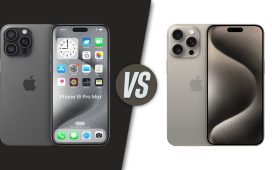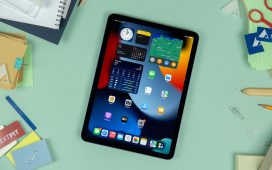So I got my hands on the 2023 generation of the Lenovo Yoga 9i for a few weeks and if you read my previous review on the Yoga 9i 2022 model, you’d know that I was pretty impressed with that one overall.
That’s still the case here with the 2023 model – this is just an incremental upgrade with not a whole lot changing as far as the features go.
Realistically, we’re looking at the same package with just a newer CPU and SSD. So while I’ll go into the most detail in the performance sections, I’ll be referring to my previous article quite frequently in terms of the design and ergonomics, as nothing has changed between iterations.
So here are my thoughts on this 2023 premium Lenovo Yoga 9i.
Specs as reviewed – Lenovo Yoga 9i 2023 8th-gen
| Lenovo Yoga 9i 2023 (gen 8) | |
| Screen | 14.0 inch, 2880×1800, OLED, 90 Hz, glossy, touchscreen, 100% DCI-P3 |
| Processor | 13th Gen Intel Core i7-1360P, 12 core total, 4 perfomance+8 eco (5.0Ghz) |
| Video | Intel Iris Xe |
| Memory | 16 GB LPDDR5-5200, soldered |
| Storage | 512GB M.2 PCIe 4.0 (Hynix HFS512GEJ9X115N) |
| Connectivity | Intel Wi-Fi AX211 + Bluetooth 5.2 |
| Ports | 1x USB-A 3.2 Gen 2, 1x USB-C 3.2 Gen 2 (PD 3.0, DP 1.4), 2x USB-C Thunderbolt 4 (PD 3.0, DP 1.4), audio jack |
| Battery | 75 Wh, 65W charger |
| Size | 318 mm or 12.52” (w) x 230 mm or 9.06” (d) x 15.25 mm or .6” (h) |
| Weight | 1.4 kg (3.09 lbs) + charger |
| Extras | 2-in-1 convertible format, HD Webcam with Windows Hello, fingerprint sensor, quad speakers (2x tweeters and 2x sub) |
Design and first look
The 2023 Yoga 9i is built on the exact same chassis as last year.
The chassis itself is an all-aluminum CNC milled unibody and is still “oatmeal” in color, which is kind of like a champagne color that you see on Asus ZenBook devices or the gold color on Apple MacBooks.
My opinions on the design are exactly the same as last year. The overall construction is solid, as there are no creaks of flex to speak of. Closed, the device is very symmetric and easy to carry around.
I won’t go too much into detail here because after rereading my previous article, my opinions are identical. Even when it comes down to the device walking occasionally when lifting the lid with one finger – it’s exactly the same here.
On top of that, the IO is the same as well: there’s a USB-A 3.2 slot and a pair of Thunderbolt 4 ports on the left-hand side. On the right, there’s a USB-C, a headphone jack, and the power button. These USB-C ports all support power delivery as well.
The main draw to this model is the 2-in-1 aspect where the screen folds all the way back, potentially making it a 14” tablet. This hasn’t changed at all from last year and it still works very well, for all intents and purposes. I still have the same worry about the polished edges over time, especially if resting the device on them while in a tented position.
The other cool aspect of this model is the 360-degree soundbar integrated into the screen hinge, which is a pretty effective way to point the sound in every direction. I’ll get more into detail about the sound in the later section, but in short, it’s a very effective solution.
Overall, the design is still great in my opinion, and lives up to expectations. I think in the next redesign though, I would ask for some minor tweaks to the little things I still have gripes with, particularly the tiny and slippery rubber feet on the bottom and the polished edges. I realize the feet can’t get taller due to the 2-in-1 format, but they certainly could be wider. As concluded last year, though, these are minor complaints.
Keyboard, touchpad, and touchscreen
The keyboard and trackpad have also not been changed between models and that’s probably for the best, as I found them both to be very good for this implementation of a laptop.
Sure the key travel is short, but the feedback is more than enough to provide a good typing experience.
As with the previous versions of the Yoga, when flipping the keyboard all the way back, it becomes disabled like it’s supposed to.
I still very much enjoyed typing on this machine, which I used to type this review. My error rate was low and my typing speed was about on average for me. I could easily use this laptop for work.
The keyboard backlighting is white on silver keys, so in daylight hours, the backlighting actually makes it harder to see what you’re typing. But there is a light sensor on these keys that you can turn on, so the backlighting only automatically comes on when it needs to. Works very well.
As for the trackpad, it’s still just as great as it was last time. I think I said I wouldn’t change a thing about it and I still mean it. It’s large enough and glass, so multitouch gestures and tracking work perfectly. And the integrated buttons take the correct amount of pressure in order to actuate.
This laptop is also touch-enabled with a digitizer so it’ll support both touch from your fingers as well as pen input. This unit comes with an included pen that appears to be specifically designed for Yoga laptops. My Wacom pen that I use for my Asus ROG Flow x16 doesn’t work on this laptop.
And this year they actually included a place to put the pen. It’s not on the laptop itself like I would have liked, but on a sleeve instead. Not ideal, but at least this included sleeve is pretty high quality and looks nice. I’d probably keep it in my bag if I were to have this laptop as my own.
As for the operation of the pen, it’s the same as before and this is the unfortunate part. The non-oleophobic screen makes the surface slightly tacky and ruins the pen-and-touch experience. If your fingers have any moisture on them whatsoever, you’ll struggle with touch as I did.
Not a deal breaker, but it still leaves that door open for Apple or Microsoft to win you over by being able to use your pen for so much more than just note taking. I’d even say that the pen experience on the Asus x16 is superior to this one. But if you’re strictly just taking notes in One Note, you’ll be fine.
Screen
I’m pretty impressed with this screen and at first glance, I thought it was the exact same one on the last Yoga 9i I reviewed. But the part number is different and is actually the same screen I saw in last year’s Slim 7 Carbon. Perhaps it is the same and is just rebranded as a Lenovo screen. The good news is they both are great panels.
What we have here is a 90Hz 2880 x 1800 px OLED screen. This screen offers perfect viewing angles, bright vibrant colors, and an unlimited contrast ratio. The OLED aspect creates a pure black that is incredibly addicting if you’re not used to it, with zero backlight bleed.
There is a tiny quirk to the screen and it’s from the digitizer. There is a slight graininess that comes from the extra layer over the panel, which shows up at extreme brightness levels, especially on a white nackground. This is not particularly annoying to me, but it does exist and is worth noting.
I used my X-rite i1 Display Pro sensor to verify all the specs. Here’s what I got:
- Panel HardwareID: Lenovo LEN140WQ+(Model LEN8A98)
- Coverage: 170.9% sRGB, 117.7% AdobeRGB, 121.0% DCI-P3;
- Max brightness in the middle of the screen: 346 cd/m2 on power;
- Gamma: 2.2
- Contrast at max brightness: 1,000,000:1
- Native white point: 6560 K;
- Black on max brightness: 0 cd/m2.
These results are almost identical to my results last year so it’s safe to say that it’s the same panel with just a rebranded model name.
To conclude though, this is the ideal panel for this type of laptop. It’s perfect for multimedia use as well as productivity. All you need to be concerned about is the potential burn in, really. The good news is we’re well over a year out on this panel (which is used by other brands as well, not just by Lenovo) and I haven’t seen any complaints about it yet.
Hardware and performance
This review sample is built on an Intel 13th-gen Intel Raptor Lake Core i7-1360P. This is an Intel Evo branded CPU, with 8 cores for performance processing and 4 additional cores for efficiency use. The lower-demand programs use these efficiency cores and they’re meant to extend battery life. There’s also 16GB of soldered RAM, so make sure that’s enough for your needs before purchasing.
I’m pretty pleased with the overall performance of this laptop. I used it quite a lot over the last month and I enjoyed every minute of it. I mostly used it as an entertaining device, but there were a couple more demanding programs I was able to test and it handled them just fine.
In case you were thinking about updating this machine, I caution you to think again. Other than the SSD, there’s nothing to update. On top of that, this laptop is a major pain to get open and it’s honestly not worth it if you ask me. Unless you really know what you’re doing, you risk breaking some of the chassis or footpads.
It may look like there are only the 6 screws on the bottom, but the top footpad strip is actually removable. It’s held on by strong 3m tape so it requires that you peel it back carefully or risk damaging that footpad permanently. Once removed there are an additional 3 screws to remove.
With all the screws removed, you now have to pry up a corner. I used a plastic removal tool and a guitar pick to get underneath one of the back corners. Then it’s just a matter of working your way around and undoing the clips. If you do this, good luck not breaking any and I hope you know what you’re doing – be patient.
Now let’s talk about the actual performance of this laptop.
And here’s how the laptop handles sustained CPU loads on the three power profiles, in the Cinebench loop test.
These are good results and a ~10% step up from the i7-1260P in the previous Yoga 9i and other ultraportable designs. At the same time, the 13th-gen Core P hardware is still outmatched in performance by Ryzen U options or the Core H platforms available in other ultraportables these days.
I took some synthetic benchmarks to get an idea of how well the CPU performs. Here’s what I got in Performance mode, which allows the CPU to start at 64W for a short burst, then settle at 38W, assuming the thermals hold up:
- 3DMark 13 – CPU Profile: Max-6331, 16T-5931, 8T-4543, 4T-3463, 2T-1991, 1T-1065;
- 3DMark 13 – Fire Strike: 5097 (Graphics – 5326, Physics – 22690);
- 3DMark 13 – Time Spy: 1873 (Graphics – 1652, CPU – 7803);
- Uniengine Superpostion – Medium: 3244;
- GeekBench 6: Single-Core: 2513, Multi-core: 9992;
- CineBench R15: OpenGL 102.29 fps, CPU 1929 cb, CPU Single Core 271 cb;
- CineBench R23: CPU 11606 pts, CPU Single Core 1857 pts;
Compared to the previous Yoga 9i generation (i7-1260P, 64 to 35W), we’re looking at 15-25% higher CPU scores in shorter-duration loads, 5-10% in sustained multi-threaded loads, and a boost of around 10% in GPU performance.
And now let’s see how it performs in “intelligent cooling” mode. In this mode the TDP starts at 64W but eventually levels off at 28W, with the fans spinning quieter:
- 3DMark 13 – CPU Profile: Max-6124, 16T-4620, 8T-3787, 4T-3045, 2T-1817, 1T-1032;
- 3DMark 13 – Fire Strike: 5180 (Graphics – 5535, Physics – 19231);
- 3DMark 13 – Time Spy: 1992 (Graphics – 1771, CPU – 6873);
- Uniengine Superpostion – Medium: 3209;
- GeekBench 6: Single-Core: 2520, Multi-core: 10509;
- CineBench R15: OpenGL 107.05 fps, CPU 1348 cb, CPU Single Core 268 cb;
- CineBench R23: CPU 9987 pts, CPU Single Core 1906 pts;
Finally, these are the results in “battery saving mode”. In this mode, the TDP starts at 45W and then shifts to 18W. Here were my results:
- 3DMark 13 – CPU Profile:Max-4434, 16T-3429, 8T-2830, 4T-2240, 2T-1427, 1T-863;
- 3DMark 13 – Fire Strike: 3959 (Graphics – 4327, Physics – 12563);
- 3DMark 13 – Time Spy: 1509 (Graphics – 1347, CPU – 4765);
- Uniengine Superpostion – Medium: 2680;
- GeekBench 6: Single-Core: 2398, Multi-core: 7561;
- CineBench R15: OpenGL 98.15 fps, CPU 925 cb, CPU Single Core 227 cb;
- CineBench R23: CPU 7525 pts, CPU Single Core 1619 pts;
There are certainly some improvements noted with these benchmarks compared to last year.
Overall, this is a capable laptop that could easily be someone’s daily driver, even for work. Of course, there are faster options out there, but not this thin and light.
I also took some benchmarks with a few games, varying in age. See below for my results:
| Performance mode, FHD 1920×1200 px resolution | |
| Doom Eternal (Low settings) | 38 fps avg, 26 fps low |
| Skyrim (Ultra, FHD+) | 60 fps avg, 38 fps low |
| The Witcher 3: Wild Hunt (FHD+, low Preset, Hairworks Off, DX11) | 41 fps avg, 31 fps low |
| Portal Reloaded | 60fps |
| Elden Ring (Low settings) | 44 fps avg, 31 fps low |
Decent results for a laptop without a dedicated GPU. The Iris Xe chip works at its full potential in this laptop, and the overall framerates are actually a 10-20% boost over the results we got for the same games last year. Of course, this is only at FHD resolution and most of the graphics settings are lowered – but this is to be expected for a non-gaming laptop.
I will add that games look absolutely incredible on this OLED screen. I’m eager to see OLED meet gaming laptops as well.
Noise, Heat, Connectivity, speakers, and others
The cooling unit on this laptop is exactly the same as in the model last year. It’s a dual-fan design with a couple of heatpipes. It does the job well.
Under normal use, the fans are generally off. Under light loads, the fans eventually kick on at around 34dB(A) or less. If you are in a quiet room, you will definitely notice this noise, but I hardly did since there is usually something going on in the background at my place.
During my heavier internet load test I did get those fans to ramp up a little. I measured only 39dB(A) of noise coming from the fans with CPU temps hanging around 55C. That’s actually very good and shows how well the loads are balanced on the CPU.
Gaming didn’t push these fans much louder. they went up to 42dB(A) and the CPU temps were 65C on average. This is nothing to complain about at all.
The good news continues with the external temps. I took some thermal images after watching a movie and again while gaming on power. Both landed about where you would expect and were certainly within tolerable limits.
*Daily Use – streaming Netflix in EDGE for 30 minutes, Silent profile, fans at 0-35 dBA
*Gaming – Performance – playing Witcher 3 for 30 minutes, fans at ~42 dBA
The same Intel AX211 Wifi 6E module is in this unit. As expected, it works excellently with measured speeds as high as 800 Mbps while 25 ft from my router. My connection was stable the whole time too. The Bluetooth 5.2 also worked just well, although I only used my Airpods to test it.
But I really didn’t use my Airpods a whole lot because the speakers were just that awesome. It was nice to get this laptop back again because the speakers are arguably my favorite implementation on a thin-and-light ultrabook to date.
Like last year, there are two 3W drivers that point down and to the side through the tiny speaker holes. This is useful to help direct the sound in different directions depending on what mode you use the laptop. More importantly, there is a multi-directional soundbar built into the hinge, that contains 2x 2W tweeters. These get quite loud and provide the perfect “center” channel while watching video content.
The sound itself is very impressive as it’s full and loud for this class of laptops. Using my test song, I measured the amplitude to get as high as 78 dB(A). The bass test hit lows as low as 60Hz. It definitely makes watching movies a joy and it also was great with games as well. There’s a quick shortcut key on the right to choose the right audio mode as well.
The only thing I can complain about with the audio is that you can feel some vibrations through the chassis. It’s not enough to make a noise on any surfaces, but you’ll certainly notice on your lap or palms if the volume is all the way up. At least it’s not distorted.
The webcam is also pretty good. It’s a FHD shooter with a sharp focus and good color reproduction. It’s clear Lenovo chose wisely and intentionally, making this machine a good choice to use for video conferencing. There’s also a dedicated button on the right-hand side to blur the background. Not exactly what I’d want a hotkey for, but maybe someone will dig it.
Windows Hello also works with this camera and it works perfectly in a bright or pitch-black room. The camera comes with a privacy shutter too but closing it will disable the face unlock aspect. There’s also a fingerprint reader on the keyboard deck if you’re into that instead of face unlock.
Battery life
There’s a 75 Whr battery inside this Lenovo Yoga 9i series, about as good as you can get at this size.
I took a series of battery life tests with the brightness at 50%, which is about 64 nits. Here were my results:
- 7.1 W (~10 h 34 min of use)– idle, Quiet mode, screen at 0%, Wi-Fi ON, backlighting off;
- 17.6 W (4 h 16 min of use)– text editing in Word with light internet use, Quiet mode, screen at 50%, Wi-Fi ON;
- 9.1 W (~8 h 15 min of use)– 1080p 60Hz Youtube fullscreen in Chrome, Quiet mode, screen at 50%, Wi-Fi ON;
- 11.6 W (~6 h 28 min of use)– 1080p Netflix fullscreen video in Chrome, Quiet mode, screen at 50%, Wi-Fi ON;
- 23.8 W (~3 h 9 min of use)– heavy browsing in Chrome, Intelligent Cooling mode, screen at 50%, Wi-Fi ON;
- 42.3 W (~1 h 46 min of use)– Gaming – Witcher 3, Extreme Performance Mode, 60fps cap, screen at 100%, Wi-Fi ON.
These results are a mixed bag for me. It looks like you’d only get 3-4 hours of actual work done on a single charge. It certainly could be worse, but I would have expected more from the Intel Evo line. At least the display’s refresh rate automatically shifts to 60Hz like it’s supposed to.
The laptop comes with a 65W charger which connects via USB-C. It’s a small size and works well. I was kind of hoping for something even smaller like a GaN charger that is on the wall itself, but maybe next year.
Price and availability- 2023 Lenovo Yoga 9i
This reviewed configuration is not yet available but will soon be for $1399.
This is a much better entry price than they offered last year and a fair value if you ask me. Here’s a link for Amazon if and when they become available. Also check out Best Buy, which has listings already loaded in their system.
There is also a dark grey model which includes a 4k screen and a 1 TB SSD for $1649. Also a fair price, but I wonder just how much better a 4k screen would look at this screen size. I also think that battery life would also be a little worse with that model.
Final thoughts- 2023 Lenovo Yoga 9i review
I’m still very happy with this Yoga 9i laptop, even though they didn’t change a whole lot between generations. In fact, they only updated the CPU… But there wasn’t really anything wrong with the last model, so I can certainly see why they left the rest of the laptop alone.
Truth is, the SSD was already fast, the screen is already great and the keyboard and trackpad are pretty much as good as they’re going to get at this size of a laptop.
On top of that, you have a great webcam with integrated biometrics, with a fingerprint reader to complement it. And let’s not forget the excellent-sounding speakers. Sure, they could probably be louder, but this is a pretty small laptop and we don’t need any excessive vibrations.
The only real thing they could improve is the IO, but that would probably require a chassis update. Perhaps we’ll see that in the next model. I’d at least like to see an SD card reader added. And maybe move that headphone jack to the other side.
Minor gripes though and I’m happy Lenovo kept the working formula going and updated the hardware and that price. That’s it for my review, though. Hope it was informative – shoot me a comment below if you have any questions.

